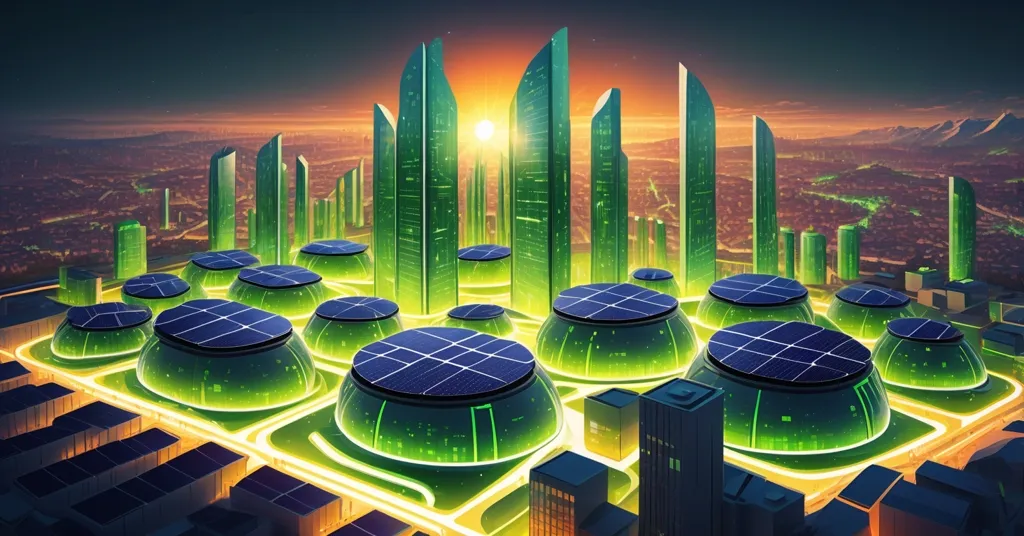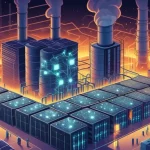Solaria and Goldman Sachs Team Up for 3.4GW Green AI Data Center Push in Europe

Solaria and Goldman Sachs Join Forces for a 3.4GW AI Data Center Power Play in Europe
Solaria Energía y Medio Ambiente SA, a Spanish solar developer, is making a bold move to power the AI revolution with clean energy, partnering with Goldman Sachs Group Inc. to secure a financial backer for a staggering 3.4-gigawatt data center platform across Europe. With AI’s insatiable hunger for electricity driving an unprecedented energy crunch, Solaria is betting on renewables to fuel the future of tech infrastructure.
- Solaria collaborates with Goldman Sachs to fund a 3.4GW AI data center initiative in Europe.
- Grid access secured in Spain, Italy, Germany, and the UK, with 5GW more under application.
- AI energy demands are projected to quadruple by the next decade, pushing this urgent initiative.
Solaria’s Big Bet on Green AI Power
Let’s cut to the chase: Artificial Intelligence is a power hog. Training a single large AI model can emit as much carbon as five cars over their lifetimes, according to MIT studies. Multiply that by thousands of models running 24/7 in data centers worldwide, and you’ve got a climate disaster brewing—unless someone steps in with a sustainable fix. Enter Solaria, a heavyweight in Spain’s renewable energy scene, aiming to flip the script by building a massive network of data centers powered by solar and other clean sources. Their 3.4-gigawatt platform isn’t just a project; it’s a potential game-changer for how Europe handles the tech explosion without choking on carbon emissions.
For those new to the energy game, a gigawatt (GW) is a billion watts—a unit of power that can light up entire cities. Solaria’s 3.4GW target is enough to run millions of servers, and they’ve already secured grid access (basically, permission to plug into the national power networks) in Spain, Italy, Germany, and the United Kingdom. They’re not stopping there, with an additional 5GW under application to expand their reach. The goal? Lock in a financial partner by summer 2025 to make this vision reality. Neither Solaria nor Goldman Sachs has spilled details publicly yet, but if they pull this off, it could set a new standard for clean-powered tech infrastructure.
Why Spain is the Perfect Launchpad
Spain is Solaria’s home turf and the beating heart of their strategy. Why? Picture this: endless sunshine for solar farms, wide-open land for sprawling projects, and transatlantic undersea cables—high-speed internet pipelines under the ocean connecting Europe to North America—that make Spain a digital gateway for global data traffic. It’s like the country was custom-built to be the Silicon Valley of solar-powered servers. But can they handle the heat of skyrocketing global demand? That’s the million-dollar question.
Solaria already holds 1.2GW of grid-connection rights specifically for data center development in Spain. One flagship project is a 200-megawatt AI data center at their Puertollano complex, covering nearly 100,000 square meters, developed with Japan’s Datasection Inc. This isn’t just a server farm; it’s a test run for what renewable-powered AI infrastructure could look like at scale. Projections suggest data centers could account for 6% of Spain’s total electricity demand by 2035—equivalent to powering millions of households non-stop. Compare that to the current 1-2% global average for data center usage, and you see why this is a staggering leap—and why Solaria is racing to meet it with clean energy.
Europe’s High-Stakes Balancing Act
Zooming out, Europe is stuck between a rock and a hard place. The nonstop bulldozer of digital growth—AI, cloud computing, and even blockchain tech—demands more electricity than ever. Meanwhile, the continent’s aggressive climate goals push for carbon neutrality, with renewable energy as the holy grail. Solaria’s move is a rare fusion of these forces, potentially showing how tech and sustainability can fuel each other. But let’s not kid ourselves—scaling this is gonna be a logistical shitstorm. Regulatory hurdles like Germany’s strict zoning laws for solar farms, or EU carbon taxes that could jack up costs if integration lags, are just the tip of the iceberg. Then there’s the reliability factor: solar power is cheaper than ever, but pairing it with the 24/7 uptime needs of data centers is no picnic.
Still, Solaria’s financials paint a rosy picture. Their shares have nearly doubled in 2024, a screaming vote of investor confidence. They’re targeting a whopping 14.3GW of total capacity by 2028 across solar, wind, and battery storage. That’s ballsy, and we love a good disruption story. But here’s the reality check: grid delays, policy flip-flops, or a cooling AI hype cycle could turn this dream into a pipe dream. Partnering with a Wall Street titan like Goldman Sachs doesn’t guarantee a win—it just means the stakes are sky-high.
The Crypto Connection: A Glimpse of Greener Mining?
Bitcoin OGs, don’t sleep on this. While Solaria’s spotlight is on AI, the energy challenges mirror what we’ve been wrestling with in crypto for years. Bitcoin mining alone guzzled over 150 terawatt-hours in 2023, per Cambridge estimates—more than some mid-sized countries. Ethereum’s shift to staking slashed its footprint, but DeFi platforms and NFT ecosystems still thirst for juice. If Solaria nails sustainable power for AI data centers, your mining rigs might finally ditch the ‘dirty energy’ label—eventually. Renewable solutions like theirs could be a lifeline for blockchain sustainability, aligning with our ethos of breaking free from centralized, fossil-fuel-dependent grids.
Don’t get too excited yet, though. Solaria isn’t mining Bitcoin or hosting Ethereum nodes—they’re chasing the bigger, shinier prize of AI with its massive corporate and governmental backing. Still, the ripple effects of their model could inspire greener crypto operations down the line. Imagine a world where decentralized tech, be it AI or Bitcoin, runs on clean, scalable power. That’s the kind of disruption we’re here for, but it’s a long road from vision to reality.
Risks and Realities of Scaling Clean Tech
Let’s play devil’s advocate with some brutal honesty. Sure, AI is the darling of tech right now, but what if the bubble bursts? Solaria’s betting the farm on a trend that might not even outlast the next crypto bull run. And even if AI demand holds, the economics of this venture are a tightrope walk. Can they deliver by 2025 without costs spiraling out of control? Will European regulators play nice, or will red tape choke their progress? Most critically, can this model scale to meet AI’s insane appetite—projected to quadruple data center power needs by the decade’s end—without buckling under its own weight?
AI might be a digital teenager, constantly hungry and burning through resources like there’s no tomorrow, but Solaria’s job is to keep the fridge stocked with green energy. Their pipeline and investor hype suggest they’ve got the chops, but execution is everything. We’ll be tracking their 2025 deal deadline and any whispers of crypto tie-ins—stay tuned for the unvarnished truth on whether they deliver.
Key Takeaways and Questions on Solaria’s Renewable AI Push
- How is AI reshaping energy needs in Europe?
AI is driving an unprecedented spike in electricity consumption, with data centers potentially quadrupling power demand by the next decade, straining Europe’s grid and challenging sustainability targets. - What sets Solaria’s data center strategy apart?
Solaria is harnessing renewable energy for a 3.4GW platform, merging sustainability with cutting-edge tech infrastructure in a way that could redefine industry standards. - Why is Spain a prime spot for AI data centers?
Spain boasts abundant sunlight for solar power, vast available land, and transatlantic cable connectivity, positioning it as a global hub for digital and energy innovation. - Could Solaria’s innovations impact Bitcoin and crypto?
Though focused on AI, their renewable energy solutions could pave the way for greener Bitcoin mining and blockchain operations, addressing long-standing sustainability critiques. - What challenges threaten Solaria’s ambitious goals?
Logistical nightmares, regulatory barriers across Europe, potential shifts in AI demand, and the sheer scale of execution could jeopardize their timeline and financial viability.



